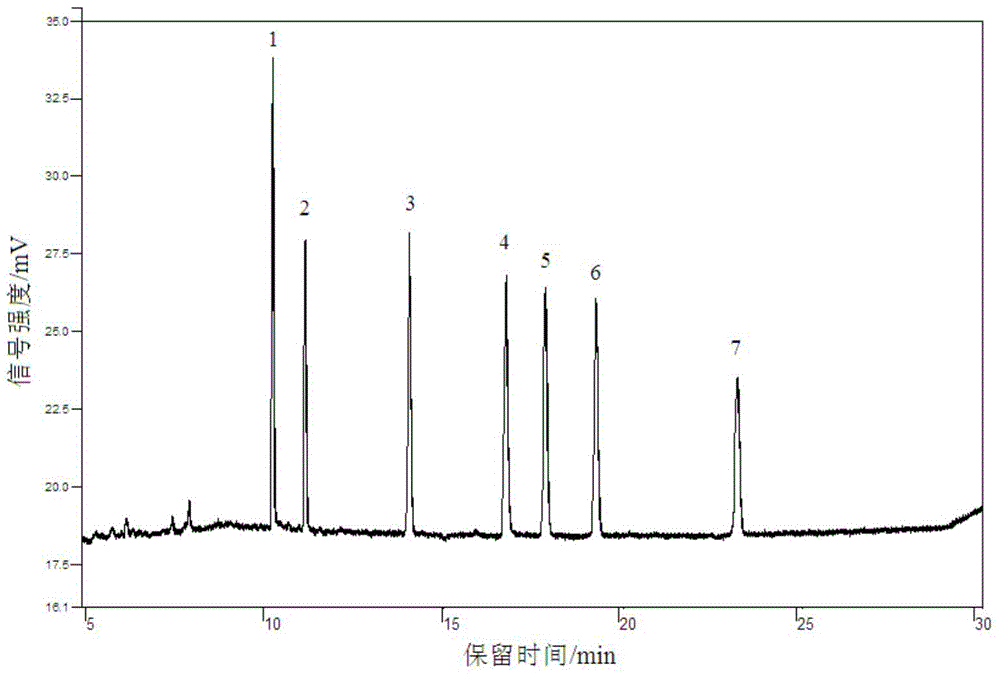Dispersive solid-phase extraction gas chromatography method for polychlorinated biphenyls in soil and sediment
A technique of polychlorinated biphenyls and gas chromatography, applied in the field of soil and sediment pollution detection, achieves high sensitivity, satisfactory recovery rate and reproducibility, and simple operation
- Summary
- Abstract
- Description
- Claims
- Application Information
AI Technical Summary
Problems solved by technology
Method used
Image
Examples
Embodiment 1
[0055] Step (1). Sample collection and sample preparation:
[0056] Pack the collected soil and sediment samples with clean aluminum foil and seal them in polyethylene bags, then transport them back to the laboratory in a portable refrigerator, dry the samples in a freeze dryer for 24 hours, and take them out through a 100-mesh stainless steel sieve , placed in a desiccator for testing.
[0057] Step (2). Sampling and ultrasonic extraction:
[0058] Weigh 10.00g of the sample to be tested, put it in a 50mL centrifuge tube, add 30mL of n-hexane, vortex for 2min, and extract with 480W ultrasonic wave at 30°C for 30min. Ultrasonic desulfurization of copper powder, 6000r / m high-speed centrifugation for 5min; observe the color of the extract, if it is basically colorless and transparent, directly proceed to step (4) concentration and constant volume, that is, only one step of purification is required, otherwise, proceed to step (3) concentrated sulfuric acid purification, that is ...
Embodiment 2
[0097] Example 2. Determination of 7 kinds of polychlorinated biphenyls in the soil samples collected from Zhujiajianjia vegetable field in Zhoushan
[0098] (1) Sample collection and sample preparation: The soil samples collected from the Jia vegetable field in Zhujiajian, Zhoushan were packed with clean aluminum foil and sealed in a polyethylene bag, and then transported back to the laboratory in a portable refrigerator, and then placed in a Dry it in a freeze dryer for 24 hours, take it out and pass it through a 100-mesh stainless steel sieve, and place it in a desiccator for testing.
[0099] Adding standards to the soil samples collected from the Zhujiajian vegetable field in Zhoushan: add 12.5, 100, and 1000 μL of 100 μg / L PCB mixed standard to 10.00 g of the treated soil samples collected from the Zhujiajian vegetable field in Zhoushan Soil samples collected from Zhujiajian Jiacai field in Zhoushan were prepared into low (0.125μg / kg), medium (1.00μg / kg) and high (10.0μg...
Embodiment 3
[0109] Example 3. Determination of 7 kinds of polychlorinated biphenyls in the mud sample collected in the sea area of Zhoushan Daiquyang multiplication and release
[0110] (1) Sample collection and sample preparation: The mud samples collected in the Zhoushan Daiquyang multiplication and release sea area were packed with clean aluminum foil and sealed in polyethylene bags, and then transported back to the laboratory in a portable refrigerator, and then the samples were placed in Dry it in a freeze dryer for 24 hours, take it out and pass it through a 100-mesh stainless steel sieve, and place it in a desiccator for testing.
[0111] Adding standards to the mud samples collected from the Zhoushan Daiquyang breeding and releasing sea area: add 12.5, 100, and 1000 μL of 100 μg / L PCB mixed standard to 10.00 g of the treated mud samples collected in the Zhoushan Daiquyang breeding and releasing sea area. solution, prepared into low (0.125μg / kg), medium (1.00μg / kg) and high (10.0...
PUM
 Login to View More
Login to View More Abstract
Description
Claims
Application Information
 Login to View More
Login to View More - R&D
- Intellectual Property
- Life Sciences
- Materials
- Tech Scout
- Unparalleled Data Quality
- Higher Quality Content
- 60% Fewer Hallucinations
Browse by: Latest US Patents, China's latest patents, Technical Efficacy Thesaurus, Application Domain, Technology Topic, Popular Technical Reports.
© 2025 PatSnap. All rights reserved.Legal|Privacy policy|Modern Slavery Act Transparency Statement|Sitemap|About US| Contact US: help@patsnap.com



